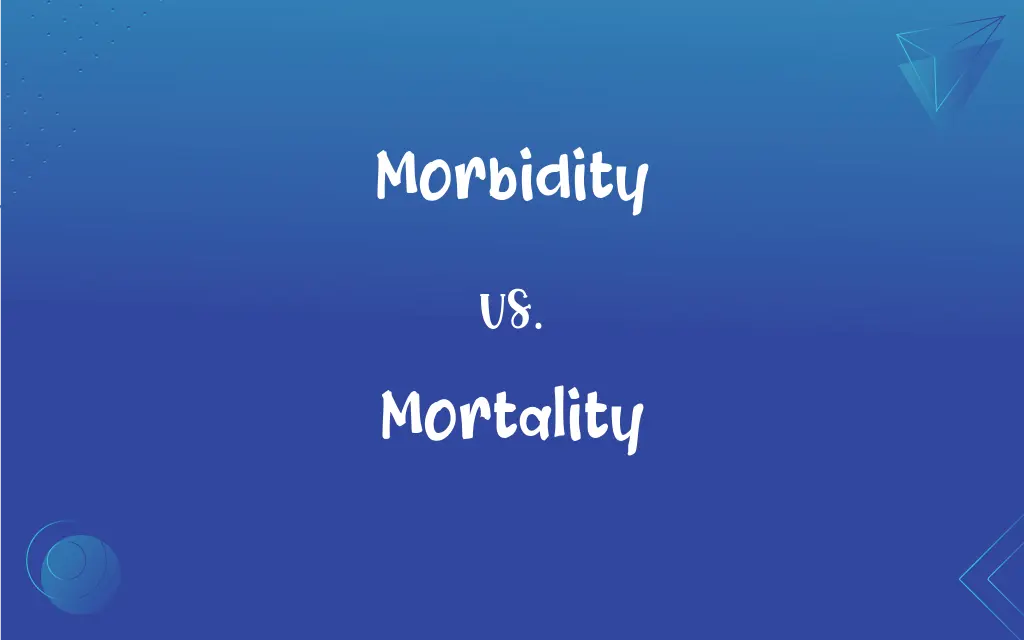Morbidity vs. Mortality: What's the Difference?
Edited by Aimie Carlson || By Harlon Moss || Updated on October 11, 2023
Morbidity refers to the rate of disease or illness in a population, while mortality pertains to the number of deaths in a population, often expressed as a rate per 1000 people.

Key Differences
Morbidity encompasses various aspects related to the incidence and prevalence of diseases and illnesses in a specific population. On the other hand, mortality specifically relates to the frequency of deaths within a population during a certain period.
It's vital to comprehend that morbidity does not inherently imply mortality, as it pertains to diseases, not their outcomes. Contrastingly, mortality intrinsically implies a terminal outcome, signaling the culmination of life.
In the realm of epidemiology, morbidity has a broader implication, often including the prevalence, incidence, and overall burden of disease within a population. Mortality, however, is starkly specific, purely focusing on the quantification and analysis of death.
Morbidity might delve into the myriad aspects of health deterioration without necessarily exploring death. On the flip side, mortality strictly adheres to investigating, understanding, and detailing aspects and patterns related to death.
A population can exhibit high morbidity without necessarily reflecting high mortality, pointing to the presence of manageably chronic or non-lethal diseases. However, high mortality unmistakably denotes a significant number of deaths within a demographic.
ADVERTISEMENT
Comparison Chart
Definition
Refers to the presence of diseases and illnesses in a population.
Refers to the number or rate of deaths in a population.
Implication of Outcome
Does not inherently imply death.
Inherently indicates death.
Scope
Can be broader, including various aspects of health deterioration.
Strictly focuses on death occurrences and their patterns.
Epidemiological Usage
Used to explore disease prevalence and incidence.
Used to explore patterns and causes of death.
Potential for High Rates
Can be high without necessarily indicating severe health crises.
High rates are typically indicative of severe health issues.
ADVERTISEMENT
Morbidity and Mortality Definitions
Morbidity
The condition of being diseased or afflicted.
The morbidity rate for the flu spikes during the winter months.
Mortality
The incidence or number of deaths in a given population during a particular period.
The global pandemic drastically increased mortality rates across the world.
Morbidity
The incidence or prevalence of a disease within a population.
Morbidity data helps public health officials plan interventions and allocate resources.
Mortality
A mortal quality, nature, or characteristic; the state of being mortal.
Philosophers often debate the implications and meanings derived from our mortality.
Morbidity
The frequency or existence of illnesses and diseases in a specific area.
Studies on morbidity in urban areas often consider factors like pollution and population density.
Mortality
The state or condition of being subject to death.
The mortality of all living creatures is a fundamental biological reality.
Morbidity
The state or quality of being unhealthful or causing disease.
The morbidity of the environment was apparent due to the prevalence of respiratory conditions.
Mortality
The proportion of deaths to population size.
The city has been struggling with increasing mortality due to several health crises.
Morbidity
A measure used in epidemiology to determine health status.
Increased morbidity in a community often leads to heightened public health interventions.
Mortality
Death on a large scale or mass death.
Wars, famines, and plagues throughout history have resulted in widespread mortality.
Morbidity
The quality of being morbid; morbidness.
Mortality
The quality or condition of being mortal.
FAQs
What does morbidity refer to in medicine?
Morbidity refers to the occurrence, rate, and severity of illness and disease in a population.
What is the primary focus of mortality in health studies?
Mortality primarily focuses on the occurrence and rate of death within a population.
Is mortality always associated with disease?
No, mortality can result from various factors, including accidents, violence, or natural causes.
What is incidence in the context of morbidity?
Incidence refers to the number of new cases of a disease occurring over a specific period.
What is prevalence concerning morbidity?
Prevalence refers to the total number of cases of a disease present in a population at a given time.
How can we reduce mortality?
By addressing its root causes through public health interventions, medical advancements, and policies.
What are common causes of mortality?
Common causes include heart disease, cancer, accidents, and chronic respiratory diseases.
What factors influence mortality rates?
Factors include healthcare access, social determinants, lifestyle, environment, and genetic factors.
How does chronic morbidity affect a population?
It can impact quality of life, healthcare costs, productivity, and may influence mortality.
Can a population have high morbidity but low mortality?
Yes, if diseases are non-lethal or managed effectively, morbidity can be high while mortality remains low.
Can a disease with low morbidity have high mortality?
Yes, if a disease is rare but highly lethal, it might have low morbidity but high mortality.
How does morbidity inform healthcare policy?
It helps identify public health issues, enabling policymakers to prioritize resources and interventions.
What is infant mortality?
Infant mortality refers to the death of infants under one year of age, often per 1,000 live births.
Is the age-specific mortality rate important?
Yes, it provides insights into death rates within specific age groups, helping to analyze population health.
Does morbidity include mental health conditions?
Yes, morbidity encompasses both physical and mental health conditions within a population.
Is morbidity concerned with the severity of diseases?
Yes, morbidity can consider the severity, duration, and other attributes of diseases.
How is mortality rate typically expressed?
Mortality rate is often expressed per 1,000 or 100,000 population and can be specific to a cause.
Can a mortality rate be zero?
It's highly unlikely, as death is an inevitable part of the life cycle.
Can morbidity rates predict mortality rates?
Not always directly, but high morbidity, especially in severe diseases, can be associated with higher mortality.
Is reducing preventable mortality a public health goal?
Yes, public health aims to reduce preventable mortality through various interventions and policies.
About Author
Written by
Harlon MossHarlon is a seasoned quality moderator and accomplished content writer for Difference Wiki. An alumnus of the prestigious University of California, he earned his degree in Computer Science. Leveraging his academic background, Harlon brings a meticulous and informed perspective to his work, ensuring content accuracy and excellence.
Edited by
Aimie CarlsonAimie Carlson, holding a master's degree in English literature, is a fervent English language enthusiast. She lends her writing talents to Difference Wiki, a prominent website that specializes in comparisons, offering readers insightful analyses that both captivate and inform.































































